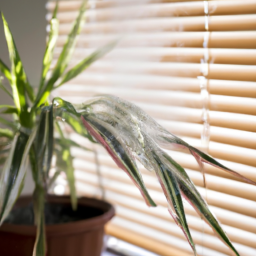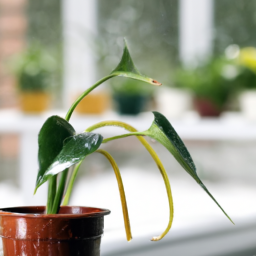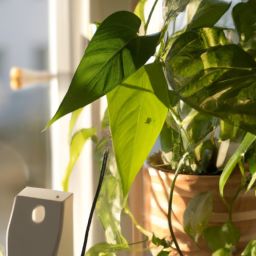
Are you a plant lover struggling to keep your indoor plants thriving? Well, look no further! In this blog post, we will explore the fascinating world of enhancing indoor plant health with humidity control. Indoor plants not only add beauty to our homes and offices but also provide numerous health benefits. However, maintaining the ideal humidity levels for our leafy friends can be a challenge. Fortunately, with the right knowledge and tools, we can create the perfect environment for our beloved plants to flourish. So, let’s dive in and discover how humidity control can revolutionize the well-being of our indoor plants!
The Importance of Humidity Control for Indoor Plants
Indoor plants not only add beauty to our living spaces but also provide numerous health benefits. They purify the air, reduce stress, and improve concentration. However, to ensure their optimal growth and longevity, it is crucial to maintain the right humidity levels. In this article, we will explore the importance of humidity control for indoor plants and provide you with a step-by-step guide to enhance their health.
Understanding the Impact of Humidity on Indoor Plants
Humidity refers to the amount of moisture present in the air. Just like humans, plants also have specific humidity requirements for their growth and well-being. Maintaining the appropriate humidity levels ensures that plants can effectively transpire, absorb nutrients, and prevent diseases.
Low humidity levels can lead to several issues for indoor plants. When the air is dry, plants lose moisture rapidly through their leaves, causing them to wilt, wither, and become more susceptible to pests and diseases. On the other hand, excessively high humidity can create a breeding ground for mold, fungi, and bacteria, leading to root rot and other fungal diseases.
By controlling humidity, you can create an optimal environment for your indoor plants, promoting healthy growth, vibrant foliage, and beautiful blooms.
Step-by-Step Guide to Enhance Indoor Plant Health with Humidity Control
Step 1: Measure the Humidity
Before taking any action, it is essential to determine the current humidity levels in your indoor space. You can use a hygrometer, a device specifically designed to measure humidity, to get an accurate reading. Hygrometers are easily available in garden centers or online. Place the hygrometer near your plants, away from direct sunlight or drafts, and note the humidity percentage.
Step 2: Adjust Humidity Levels
Once you have measured the humidity, you can take appropriate steps to adjust it according to your plants’ needs.
For Low Humidity:
– Group your plants together: By clustering your plants, you can create a microclimate with higher humidity levels. As plants release moisture through transpiration, the surrounding air becomes more humid.
– Use a pebble tray: Fill a tray with water and place it beneath your plants. As the water evaporates, it increases the humidity around the plants. Make sure the pots are not sitting directly in the water to avoid root rot.
– Mist the leaves: Regularly misting your plants’ leaves with water can increase humidity levels. However, avoid misting plants with hairy leaves as it can promote fungal growth.
For High Humidity:
– Increase ventilation: Proper airflow is crucial for reducing excessive humidity. Open windows, use fans, or install an exhaust fan to improve air circulation and remove excess moisture.
– Use a dehumidifier: If your indoor space consistently has high humidity levels, investing in a dehumidifier can be beneficial. It will efficiently remove excess moisture from the air, creating a healthier environment for your plants.
– Monitor watering practices: Overwatering can contribute to high humidity levels. Ensure that you water your plants appropriately, allowing the soil to dry out slightly between waterings.
Step 3: Monitor and Adjust
After implementing humidity control measures, it is crucial to monitor the changes and make adjustments as necessary. Regularly check the humidity levels using the hygrometer and observe your plants’ response. If you notice any signs of stress or disease, reassess the humidity and make further adjustments as needed.
Remember, every plant has different humidity requirements, so it is essential to research and understand the specific needs of your indoor plants. By providing them with the optimal humidity levels, you will create an environment where they can thrive and flourish.
Conclusion
Humidity control is a vital aspect of indoor plant care. By maintaining the right humidity levels, you can ensure healthy growth, prevent diseases, and enhance the overall well-being of your indoor plants. Remember to measure the humidity, adjust it accordingly, and regularly monitor and adjust as needed. With these steps, you will be well on your way to creating an ideal environment for your beloved indoor plants.

Techniques for Maintaining Optimal Humidity Levels for Indoor Plants
Indoor plants not only enhance the aesthetic appeal of our living spaces but also contribute to our overall well-being by purifying the air and reducing stress. However, maintaining the right humidity levels is crucial for their health and vitality. In this guide, we will explore various techniques to enhance indoor plant health through effective humidity control.
Understanding the Importance of Humidity for Indoor Plants
Before diving into the techniques, it’s essential to understand why humidity is vital for indoor plants. Most indoor plants originate from tropical or subtropical regions where humidity levels are high. Therefore, replicating these conditions is crucial for their growth and well-being.
Humidity plays a crucial role in several plant functions, including transpiration, nutrient uptake, and photosynthesis. If the humidity levels are too low, plants may experience stress, wilting, and leaf damage. On the other hand, excess humidity can lead to fungal diseases and root rot. Striking the right balance is key to maintaining optimal plant health.
Now, let’s explore some effective techniques for maintaining the ideal humidity levels for your indoor plants:
1. Grouping Plants Together
One simple and effective way to increase humidity around your indoor plants is by grouping them together. When plants are placed close to each other, they create a microclimate with higher humidity levels. As plants transpire, they release moisture into the surrounding air, creating a humid environment that benefits all the plants in the group.
Grouping plants together also helps create a visually appealing display. You can arrange them based on their humidity requirements, placing moisture-loving plants closer to each other. This technique not only enhances the health of your plants but also adds a touch of natural beauty to your indoor space.
However, it’s important to monitor the moisture levels regularly to prevent any potential issues such as overwatering or the spread of pests and diseases. Each plant’s specific needs should be considered when grouping them together.
2. Using Humidity Trays or Pebble Trays
A humidity tray or pebble tray is a simple yet effective tool for increasing humidity around your indoor plants. To create a humidity tray, fill a shallow tray or saucer with water and place it beneath your potted plants. You can also add decorative pebbles or stones to the tray, ensuring the plant’s pot is elevated above the water level.
As the water evaporates, it increases the humidity around the plants. The pebbles or stones prevent the plant’s roots from sitting directly in water, avoiding waterlogging and root rot. This technique is particularly beneficial for plants that require higher humidity levels, such as ferns, orchids, and tropical plants.
Remember to regularly check the water level in the tray and refill it as needed. This method is cost-effective and easy to implement, making it a popular choice among indoor gardeners.
3. Utilizing Humidifiers
If you live in a dry climate or struggle to maintain adequate humidity levels, investing in a humidifier can greatly benefit your indoor plants. Humidifiers are devices that emit water vapor into the air, increasing the overall humidity in a room.
There are various types of humidifiers available, including ultrasonic, evaporative, and steam humidifiers. Ultrasonic humidifiers use ultrasonic vibrations to produce a fine mist, while evaporative humidifiers use a fan to blow air over a wet wick or filter. Steam humidifiers, as the name suggests, produce steam by heating water.
When using a humidifier, it’s important to choose one suitable for the size of your room and the specific needs of your plants. Place the humidifier near your plants, but ensure it doesn’t directly blow air onto them, as this can cause damage. Regularly clean and maintain the humidifier to prevent the growth of bacteria or mold.
Humidifiers not only benefit your plants but also improve the overall air quality in your home, making them a worthwhile investment for both your health and the health of your indoor garden.
By implementing these techniques for maintaining optimal humidity levels, you can ensure the health and vitality of your indoor plants. Remember to regularly monitor the humidity levels, as different plants have varying requirements. With proper humidity control, your indoor plants will thrive and contribute to a healthier and more vibrant living environment.

Benefits of Humidity Control in Enhancing Indoor Plant Health
Indoor plants not only add beauty to our living spaces but also provide numerous health benefits. However, maintaining the right level of humidity is crucial for their overall well-being. In this guide, we will explore the benefits of humidity control in enhancing indoor plant health and provide you with practical tips to ensure your plants thrive.
1. Improved Air Quality
Humidity control plays a significant role in improving the air quality within your home or office space. When the air is too dry, indoor plants can suffer from dehydration, leading to wilting leaves and stunted growth. On the other hand, excessive humidity can create a breeding ground for mold, mildew, and other harmful microorganisms, which can negatively impact both your plants and your health.
By maintaining optimal humidity levels, typically between 40% and 60%, you can create a healthier environment for your indoor plants. This ensures they receive adequate moisture without being susceptible to diseases caused by excessive moisture or dryness.
Furthermore, plants naturally release moisture through a process called transpiration. This moisture helps to increase the humidity in the surrounding air, creating a more balanced and comfortable atmosphere for humans as well.
2. Enhanced Growth and Development
Proper humidity control can significantly enhance the growth and development of your indoor plants. When the air is too dry, plants struggle to absorb water through their roots, leading to nutrient deficiencies and hindered growth. Additionally, low humidity levels can cause the edges of leaves to turn brown and curl, indicating moisture loss.
On the other hand, high humidity can impede plant growth by limiting the intake of carbon dioxide, which is essential for photosynthesis. It can also encourage the growth of fungi and bacteria, leading to root rot and other diseases.
By maintaining an optimal humidity level, you provide your plants with the ideal conditions for healthy growth. The right balance of moisture in the air allows them to effectively absorb water and nutrients, leading to lush foliage, vibrant flowers, and stronger root systems.
3. Pest Prevention
Controlling humidity can also help prevent pest infestations in your indoor garden. Many common plant pests, such as spider mites and aphids, thrive in dry environments. By increasing the humidity, you create a less favorable habitat for these pests, reducing the risk of an infestation.
However, it is important to strike a balance, as excessively high humidity can attract other pests, such as fungus gnats and whiteflies. Regularly monitoring and adjusting the humidity levels will help you find the sweet spot where pests are kept at bay while your plants flourish.
Additionally, maintaining proper humidity levels can strengthen your plants’ natural defenses against pests. When plants are stressed due to low humidity, they become more vulnerable to attacks. By providing them with the right amount of moisture, you can help boost their immune systems and increase their resilience to pests and diseases.
In conclusion, humidity control is a critical aspect of maintaining healthy indoor plants. By ensuring optimal humidity levels, you can improve air quality, promote growth and development, and prevent pest infestations. Remember to regularly monitor and adjust the humidity levels to provide your plants with the best possible environment for thriving.
I’ll leave you with these final thoughts
Indoor plants can bring life and beauty to any space, but keeping them healthy can sometimes be a challenge. One often overlooked factor in maintaining plant health is humidity control. Just like humans, plants thrive in certain humidity levels, and providing the right amount of moisture in the air can make a significant difference in their overall well-being.
Humidity is the measure of moisture in the air, and it plays a crucial role in plant growth. However, many homes and offices tend to have dry air, which can lead to a variety of issues for indoor plants. Low humidity levels can cause plants to lose moisture through their leaves faster than they can absorb it, resulting in dry and withered foliage. Additionally, dry air can create an ideal environment for pests like spider mites, which can wreak havoc on your beloved plants. By controlling humidity levels, you can create a more suitable environment for your indoor plants, promoting healthier growth and reducing the risk of pest infestations.
Curious Minds Asked, We Responded. Frequently Asked Questions:
Q1: How does humidity affect indoor plant health?
A1: Humidity plays a crucial role in maintaining the health of indoor plants. It refers to the amount of moisture present in the air. Adequate humidity levels are essential for plants as they help regulate transpiration, the process through which plants release water vapor. When humidity is too low, plants can suffer from dehydration and wilting. On the other hand, excessive humidity can create a breeding ground for mold, fungus, and pests, leading to root rot and other diseases. Therefore, maintaining the right humidity balance is vital for optimal plant growth.
Q2: What is the ideal humidity level for indoor plants?
A2: The ideal humidity level for most indoor plants falls between 40% and 60%. However, specific plants may have different preferences. Tropical plants, for instance, thrive in higher humidity levels, while desert plants prefer lower humidity. It’s important to research the specific needs of your plants to provide them with the appropriate humidity conditions. Investing in a hygrometer, a device that measures humidity, can help you monitor and adjust humidity levels accordingly.
Q3: How can I increase humidity for my indoor plants?
A3: There are several methods to increase humidity for indoor plants. One effective approach is misting the plants with water using a spray bottle. This provides a temporary boost in humidity, especially during dry periods. Placing a tray filled with water near the plants also helps as the water gradually evaporates, increasing humidity levels. Another option is using a humidifier, which releases moisture into the air consistently. Lastly, grouping plants together creates a microclimate where transpiration from one plant increases humidity for others.
Q4: How can I decrease humidity for my indoor plants?
A4: Lowering humidity levels for indoor plants can be achieved through various methods. Using a dehumidifier is a popular option as it removes excess moisture from the air. Proper ventilation, such as opening windows or using fans, can also help reduce humidity. Additionally, avoiding overwatering plants and allowing the soil to dry out between waterings prevents excess moisture buildup. If specific plants require even lower humidity levels, using a moisture-absorbing material like silica gel near the plants can be beneficial.
Q5: What are the signs of improper humidity for indoor plants?
A5: Improper humidity levels can manifest in various ways. When humidity is too low, plants may exhibit dry and crispy leaves, wilting, or an overall lack of growth. On the other hand, excessive humidity can cause yellowing leaves, mold or fungal growth, and an increase in pest infestations. It’s important to observe your plants closely and look for these signs to determine if humidity adjustments are necessary. Remember, finding the right balance is key to maintaining healthy and thriving indoor plants.

James Wong is a renowned ethnobotanist, plant scientist, and local television presenter. With a passion for demystifying plant science, he is known for translating complex botanical concepts into practical advice for everyday plant enthusiasts. James’s expertise spans from traditional gardening to cutting-edge plant technologies, making his insights accessible and informative.


